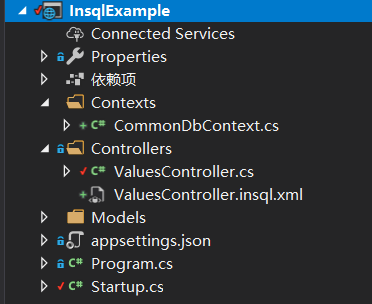项目主页:https://rainrcn.github.io/insql
在上一文中介绍了Insql的基本使用方式,这一文将介绍另一种公用数据库上下文的使用方式。废话就不多说了,直接上代码吧。
文件结构
先看一下例子的项目文件结构

我们将在ValuesController中直接通过CommonDbContext来调用ValuesController.insql.xml中的SQL
CommonDbContext
CommonDbContext<> 只建立一个并将它用在所有地方。
//TScope 是一个范围类型,可以随意指定,但是需要与 insql type 类型对应
public class CommonDbContext<TScope> : DbContext where TScope : class
{
public CommonDbContext(CommonDbContextOptions<TScope> options) : base(options)
{
}
protected override void OnConfiguring(DbContextOptions options)
{
//SQL解析器限定为`TScope`范围
options.UseSqlResolver<TScope>();
//指定所用数据库
options.UseSqlServer("数据库连接字符串");
}
}
public class CommonDbContextOptions<TScope> : DbContextOptions<CommonDbContext<TScope>> where TScope : class
{
public CommonDbContextOptions(IServiceProvider serviceProvider) : base(serviceProvider)
{
}
}Startup.cs 中注册 CommonDbContext
public void ConfigureServices(IServiceCollection services)
{
//注册Insql
services.AddInsql();
//注册公用的数据库上下文
services.AddScoped(typeof(CommonDbContext<>));
services.AddSingleton(typeof(CommonDbContextOptions<>));
}ValuesController
ValuesController.cs 或者在其他 Controller 中使用 CommonDbContext,也可以用在 Domain Service 中具体在哪里使用取决于自己。
[Route("api/[controller]")]
[ApiController]
public class ValuesController : ControllerBase
{
private readonly DbContext dbContext;
//CommonDbContext<TScope> TScope限定为当前Controller,这样在insql type中需要对应这个类型。
public ValuesController(CommonDbContext<ValuesController> dbContext)
{
this.dbContext = dbContext;
}
[HttpGet]
public ActionResult<IEnumerable<string>> Get()
{
//查询用户
var user = this.dbContext.Query<UserPo>("GetUser", new { userId = "tom" });
//添加用户
this.dbContext.Execute("InsertUser", new UserPo
{
UserId = "tom",
UserName = "tom",
CreateTime = DateTime.Now
});
//查询角色列表
var roleList = this.dbContext.Query<RolePo>("GetRoleList");
return new string[] { "value1", "value2" };
}
}ValuesController.insql.xml
<!--insql type与CommonDbContext的 TScope对应-->
<insql type="InsqlExample.Controllers.ValuesController,InsqlExample" >
<!--定义UserPo类型数据库字段到对象属性映射-->
<map type="InsqlExample.Models.UserPo,InsqlExample">
<key name="user_id" to="UserId" />
<column name="user_name" to="UserName" />
<column name="create_time" to="CreateTime" />
</map>
<map type="InsqlExample.Models.RolePo,InsqlExample">
<key name="role_code" to="RoleCode" />
<column name="role_name" to="RoleName" />
<column name="role_order" to="RoleOrder" />
</map>
<select id="GetUser">
select * from user_info where user_id = @userId
</select>
<insert id="InsertUser">
insert into user_info (user_id,user_name,create_time) values (@UserId,@UserName,@CreateTime)
</insert>
<select id="GetRoleList">
select * from role_info order by role_order
</select>
</insql>这样可以在其他位置注入 CommonDbContext
可以进项目主页查看详细文档:https://rainrcn.github.io/insql
之后将会介绍在新版本中,在不需要写XML SQL的情况下使用扩展方法来实现对象的简单CURD操作